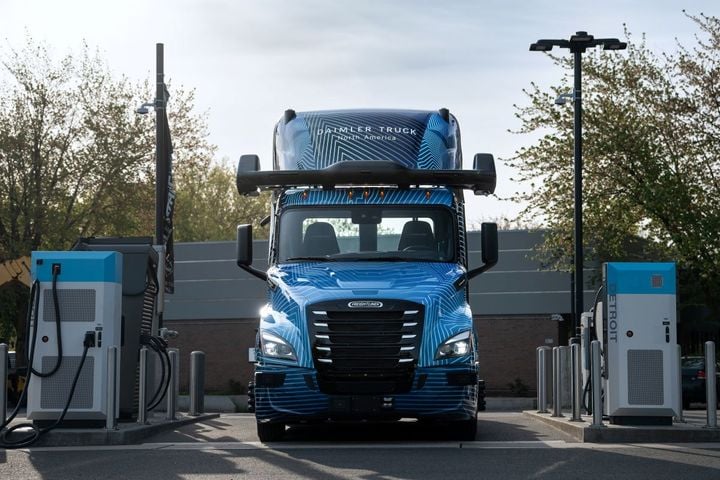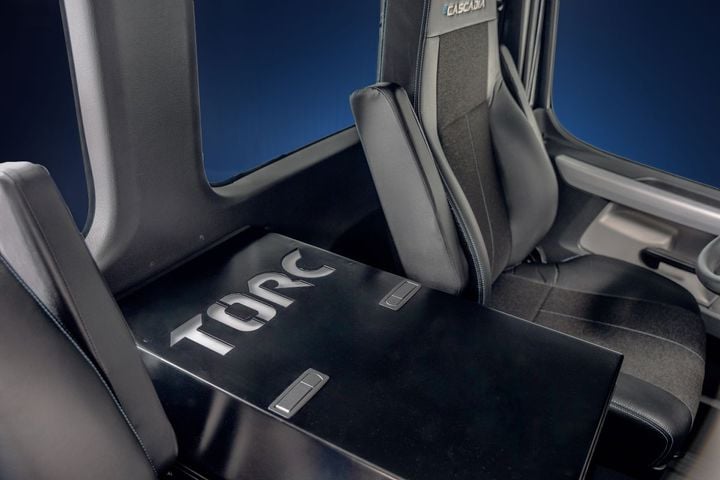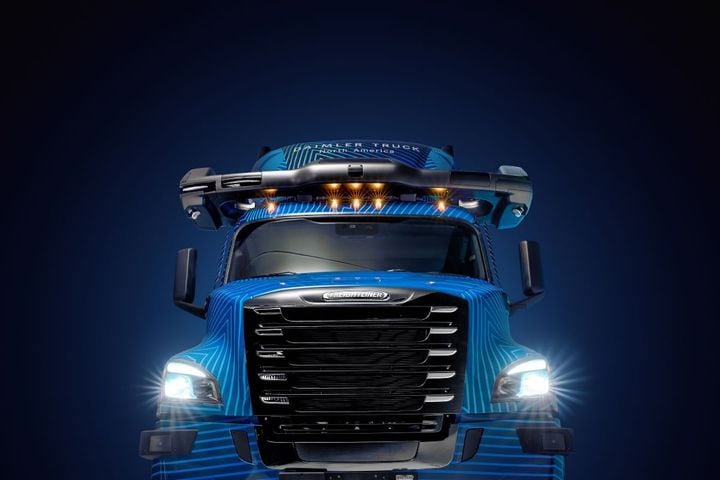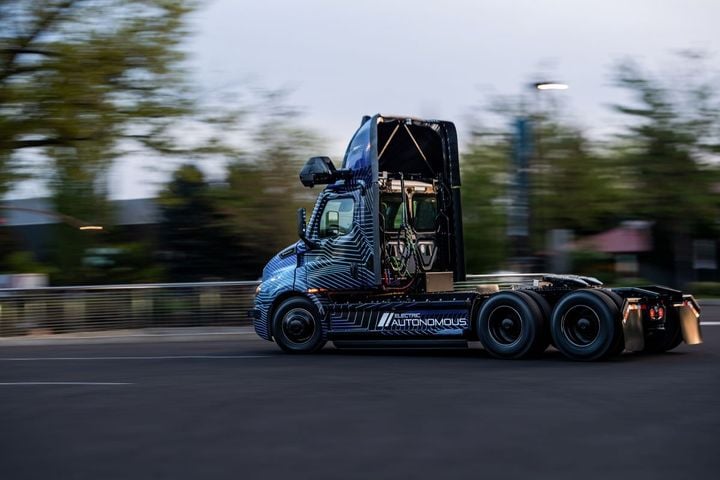Trucker Access › Forums › Diesel News › Daimler to Merge Autonomous Driving with Battery Electric Propulsion – Fuel Smarts
- This topic has 0 replies, 1 voice, and was last updated 11 months, 1 week ago by
 EazyRiDer66.
EazyRiDer66.
-
AuthorPosts
-
May 9, 2024 at 1:15 am #19173
 EazyRiDer66Keymaster
EazyRiDer66Keymaster

This 116-inch-BBC day cab eCascadia will serve as a technology demonstration platform for Daimler Truck’s future autonomous expansion.
Photo: Daimler Truck North America
Daimler Truck is a step closer to achieving its safety and sustainability goals. The company unveiled a battery-electric eCascadia daycab equipped with an integrated autonomous driving stack from Torc Robotics. The 116-inch BBC day cab will serve as a technology demonstration platform.
The truck was revealed during a media conference on May 8, 2024. While still a research and advanced engineering project, the autonomous vehicle has the potential to evolve into a scalable, propulsion agnostic platform for flexible use in different trucking applications. The goal is to offer customers a choice of the right vehicles for their specific business and transportation needs.
Automomous Trucks in 2027
Daimler plans to have SAE Level 4 trucks in commercial hub-to-hub service by 2027 using traditional diesel engines, but development teams will soon begin exploring promising use cases for autonomous-electric technology.
“By combining zero-emission and autonomous technologies in one product, we are testing solutions for challenges our customers are likely to face in the future,” said John O’Leary, president and CEO of Daimler Truck North America. “We want to give them choices that allow them to do what they do best. This truck is a great example of the beginning of that development process.”
In the currently tested hub-to-hub application, the intent is to drive autonomously between freight centers along U.S. highway corridors. By identifying synergies between zero emissions and autonomous infrastructure in a future scenario, the charging infrastructure and autonomous freight hubs could be combined to charge and load simultaneously.
Depending on the application, future autonomous trucks could also be powered by hydrogen-based propulsion technologies. Daimler Truck said it will leverage the highly scalable and profitable market opportunity that autonomous driving is expected to offer. The company sees autonomous trucking generating revenues of 3 billion Euro (US $3.22 billion) and EBIT of more than 1 billion Euro (US$1.07 billion) as early as 2030.
Reliability Growth
Daimler Truck began developing and testing autonomous truck technology in 2015 with the reveal of the Freightliner Inspiration Truck. It was the first licensed SAE Level 2 autonomous commercial truck to operate on open U.S. public highways.
[embed]https://www.youtube.com/watch?v=FkTghnItmxk[/embed]
Daimler Truck took a majority stake with autonomous technology developer, Torc Robotics, in 2019. Since 2022, Daimler has been working with logistics companies such as Schneider and C.R. England testing autonomous-ready trucks in real-world applications moving customer freight autonomously on its test route between Phoenix and Oklahoma City – a distance of about 960 miles, still far beyond the range of current battery electric technology.
As well, Daimler partnered in 2020 with Waymo to bring the autonomous ready redundant platform to market, designed and built upon 1,400 unique requirements needed for safe and reliable operation.
In January, Daimler Truck and Torc Robotics selected Lidar developer, Aeva, as the supplier of long-range 4D Lidar technology. Daimler Truck intends to integrate the Lidar sensors directly in its production process, eliminating the need to retrofit the sensors.

Engineers have managed to fit the entire compute stack into the spacebetween the seats of a day cab eCascadia. It uses a prototype air cooling system to optimize the operating environment.
Photo: Daimler Truck North America
“We believe we now have all the ingredients to drive success in this market by 2027,” said Joanna Buttler, head of Daimler Truck’s global autonomous technology group.
The next challenge, beyond 2027, will be charging infrastructure. Buttler said the company wants to avoid introducing any additional inefficiencies to the day-to-day operations and is looking at routes and locations for autonomous terminals that align with customers’ needs.
“We’re thinking about those types of challenges today so we’ll have a solution tomorrow when the time is right, the technology is ripe, and the customers are ready,” she said.
Merging the Best of Both Worlds
The truck revealed during a media conference call was a 116″ BBC eCascadia daycab. It’s a full Class 8 chassis with a gross vehicle weight rating of 82,000 pounds, and a payload capacity of about 43,000 pounds, Daimler Truck said, adding, this is the first time the full sensor suite and computer stack has been fitted to an all-electric daycab.
It has a 6×4 drivetrain featuring two Detroit e-axles with a combined power rating of 425 horsepower. Battery capacity of 438 kw/h gives it a range of about 230 miles. It can charge from zero to 80% in about 2.5 hours using a single-cable CCS 1 connector, or in about 90 minutes with a two-cable configuration.

The upper sensor bar, above the windshield includes stereoscopic cameras, long and short range radar and Lidar all fitted into an aero-optimized subassembly.
Photo: Daimler Truck North America
The demonstration truck features three short range radars, six long range radars, long- and short-range Lidar and about 15 cameras — some of which are stereoscopic. This gives very rich perceptual information for the virtual driver to make the necessary driving decisions.
Some of the perception sensors are installed onto the bumper area, while the remaining perception sensors are integrated into the upper sensor bar, above the windshield. The sensor bar is new. It’s designed to protect the sensors from the elements while retaining all the aerodynamic advantages of an integrated assembly.
“This truck is an extremely solid foundation upon which we can learn what it means to integrate the motion control elements of an autonomous vehicle system and about the integration of perception sensors,” said Suman Narayanan, director of engineering for Daimler Truck North America. “This truck will also help us understand how to balance the power consumption by the autonomous computer with most important requirement of an electric vehicle; range.”
Balance of Power
Narayanan said he anticipates a “fractional hit in the range” based on today’s configurations and experience with power consumption in a diesel configuration. Back of the envelope calculations suggest that consumption, including powering the perception sensors, the compute stack, and other autonomous related technology is about 3.5 kw of addition load on the batteries.
“The most important element that the customer expects from a battery electric vehicle is the range,” he said. “If today we have a range of up to 230 miles to haul about 43,000 pounds, we want to make that our goal. How do we optimize the consumption? How do we leverage aerodynamic efficiencies that we are developing in this product that will help us address that?”
Those are questions Narayanan and his team will address with this demonstrator truck.

Electric motion control will present a learning curve compared to diesel. The virtual driver will have to relearn how to drive, just like human drivers transitioning to BEVs.
Photo: Daimler Truck North America
New to this truck configuration is the compute stack installation. It’s packaged between the seats and the space behind the passenger seat. It also has a prototype air cooling system to ensure the system stays at its optimum operating temperature. The compute system also has its own dedicated power supply and a back-up system with four lead-acid batteries mounted behind the cab, so the computer stays powered even when the high voltage battery system is inactive.
Learning to Drive Electric
Daimler and Torc have learned a thing or two about managing diesel trucks with computers, but there a learning curve ahead with electric propulsion.
Like human drivers, the virtual driver will have to learn how to feather the accelerator pedal and manage regenerative braking opportunities to its best advantage. Narayanan said that would be one of the priorities with the new demonstrator.
“First and foremost, what kind of learning we can have on motion control?” he asked. “For instance, the robotic operation of a diesel propelled vehicle with an automated manual transmission is something that we have been learning over the last five years. This is our chance to understand what kind of motion control changes what kind of motion control adaptations we must make in order to propel a battery electric vehicle.”
Further, the vehicle’s evaluations capabilities will eventually be expanded to include a hydrogen fuel cell solution or hydrogen internal combustion solution.
“This is our chance to understand what propulsion agnosticism means for autonomous driving,” he added.
By expanding its testing and development capabilities, Daimler Truck will be able to provide customers the optimal vehicle solutions, utilizing various propulsion technologies, to enable the most suitable and efficient transportation of their goods, the press release noted.
-
AuthorPosts
- You must be logged in to reply to this topic.